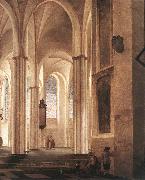Wholesale Oil Painting No Minimum |
|||||||||||
|
|
|||||||||||

|
|||||||||||
|
|
|
||||||||
Pieter Jansz Saenredam1597-1665 Dutch Pieter Jansz Saenredam Gallery Saenredam was the son of the print maker and draughtsman Jan Pietersz Saenredam (1565-1607), who was born in Zaandam or, in those days, Saenredam. In 1612 he moved to Haarlem, where he became a pupil of Frans de Grebber and lived the rest of his life. A contemporary of Rembrandt, he is noted chiefly for his surprisingly modern paintings of churches. Saenredam achieved this modern look by meticulously measuring and making sketches of the churches he wanted to paint. He would make these sketches in pencil, pen, and chalk, then and add in water colors to help give the sketch texture and color. The sketches are very architectural in detail, they convey the interior atmosphere through the clever use of light and graduated shadows. Saenredam often deliberately left people out of his work, thus also focusing more attention on buildings and their architectural forms. Only after having made precise measurements, and precise sketches and drawings of the churches, he would take them to his studio where he started to create his paintings. The Reformation led to a rise in Protestant art, of which Saenredam??s Interior of the St. Martin's Dom in Utrecht is an example. As a Catholic church the Dom had been built with adornments. Then, in the epoch of the Eighty Years War and with the church getting in Protestant hands, it was ??cleaned?? of Catholic influences. The altarpieces and statuary were removed, and the walls and ceiling were white washed. The painting shows the church not long after its make-over. The sparse interior with illuminated corridors reflect Protestant ideals, new for Saenredam's time. Alternatively, the paintings of church interiors by Saenredam and other 17th century Dutch painters have been interpreted as having less to do with religion and more with the new-found interest in perspective and with the Dutch interpretation (known as Dutch Classicism) of Palladio??s theories of proportion, balance and symmetry. In any case, Saenredam wanted to memorialize his country during this time of change by documenting many of the country??s buildings. Many artists before him had specialized in imaginary and fanciful architecture, but Saenredam was the first to focus on existing buildings. According to the J. Paul Getty Trust ??Saenredam??s church paintings??owe their poetry to his remarkable blend of fact and fiction. He began by making site drawings of buildings that record measurements and detail with archaeological thoroughness.?? This meticulous preparation helped him to create such accurate and enchanting paintings. The measurements aided him in using scientific linear perspective, just like Andrea Pozzo. He was able to use his measurements to create a realistic image with depth. The Utrecht Archives houses a large number of Saenredam's drawings. In the season 2000-2001 the Centraal Museum at Utrecht held a major exhibition of his drawings and paintings. Perhaps his best known works are a pair of oil paintings both titled Interior of the Buurkerk, Utrecht. One hangs in London's National Gallery, the other in the Kimbell Art Museum in Fort Worth, Texas. In their simplicity and semi-abstract formalism, they foreshadow more modern works such as those of Mondrian and Feininger. |
||||||||
|
|
||||||||
The Interior of the Buurkerk at Utrecht
The Interior of the Buurkerk at Utrecht Painting ID:: 32505 |
1644
Oil on oak, 60 x 50 cm 1644 Oil on oak, 60 x 50 cm |
|||||||
|
CONTACT US |

